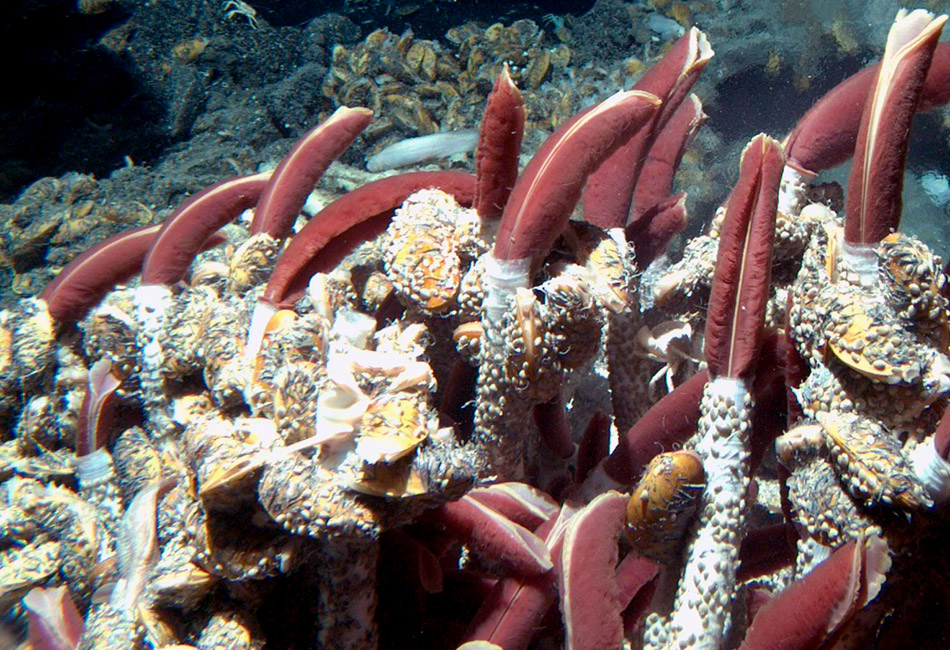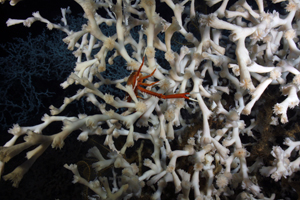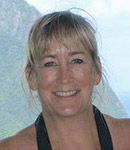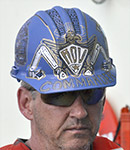Expedition 15:
Jan. 2 - 22, 2014
|
NEW Hot Topics!
Vent Ecosystems 
You Feed Me, I Feed You: Symbiosis Pump It UpJanuary 15, 2014 (posted January 16, 2014) Yesterday we heard about one of the most high-tech scientific devices aboard Atlantis—the Isobaric Gas-Tight sampler (IGT). But a huge amount of the research will rely on samples collected by a much simpler instrument: the Large Volume Pump (LVP), a device that sucks up hundreds of liters of vent fluid. Up close, it doesn’t look like much. It’s a 3-foot-tall metal frame holding a motor, a filter, some hoses, and a cylinder filled with batteries and electronics. At the ocean floor, Jason can move the device to a vent and place the LVP’s wand—a metal tube that connects to the pump with a long hose—right into fluids emerging from vents. For the next 8 to 16 hours, the pump will draw in huge amounts of fluid and push it through the saucer-sized filter. Any microbes in the fluid are captured on the filter for later study. The researchers need the LVP to get enough microbes to work with. The thriving vent ecosystem is home to thousands of kinds of microbes, but a single drop or even a test tube full of vent fluid wouldn’t contain enough cells to do the kind of experiments the scientists have planned. Back aboard the ship, WHOI microbiologist Stefan Sievert shows me one of the filters that was recovered earlier today. It looks grainy and slightly brown, and tiny flecks of dark material dot its surface. It reminds me of a thin tortilla. Sievert carefully cuts the filter into pieces and stuffs each one into a plastic test tube before popping it into a freezer. Ultimately, Sievert wants to use these samples to understand exactly how the microbes at the vents convert chemicals into energy. What methods do they use? What molecules inside them make those complex chemical reactions possible? A team approachTo answer questions like those, Sievert said, he’s turning to colleagues all over the globe, each of whom will study the samples from a slightly different angle. At Woods Hole, he and his lab will look at the microbes’ DNA—a sort of chemical “instruction manual” for the cell. The DNA can provide clues to the specific ways the microbes might “eat” chemicals at the vents. Sievert will collaborate on the work with Xiao Xiang, who is also aboard Atlantis, as well as with Fengping Wang, a microbiologist in Shanghai, China. DNA is just one of the substances that the researchers will study. Costa Vetriani and other scientists will also look at a molecule called messenger RNA, or mRNA. As its name suggests, mRNA acts like a messenger inside the cell: First it copies the “instructions” coded in the microbe’s DNA, and then it moves to other parts of the cell, where specific proteins are made according to the instructions carried by each mRNA. “RNA can give us a sense of which genes are active in the microbes,” said Sievert. “If we see that it’s reading a particular gene, we can be pretty sure that the microbe needs that gene to survive.” An array of molecules to analyzeSievert’s colleague Thomas Schweder in Greifswald, Germany, will study the cells’ proteins. These are the molecules that actually convert chemicals into energy at the vents. Other researchers, such as graduate student Miriam Sollich, who is with us on the cruise, will study lipids in the sample. Lipids are fatty and waxy substances that make up the cell membrane of the microbe. By studying those lipids, Sollich and her advisor Solveig Bühring will be able to tell which types of organisms are living at the vents. Most of the microbes at vent sites are bacteria, she said, but there are also some called “archaea.” The two kinds of single-celled life forms have different types of lipids in their cell membranes, so analyzing these molecules can tell the researchers how much of each type of organism is currently living at a vent. In all, none of these methods alone can tell the researchers everything there is to know about the microbes living at vents, or how they can survive on vent fluid, said Sievert. “Each approach has its limitations, but together, they’re helping us complete the puzzle of life at the vents.”
Get to know the crew Allison Heater is an SSSG, or Shipboard Scientific Services Group technician, on the Atlantis for this expedition. During a single shift at work, she might fix a satellite connection, solve a software problem, help deploy and recover instruments, attend meetings of the science team, and repair a broken sampler—while remaining calm and diplomatic in the midst of frantic activity. It’s not a job for everyone, but she loves it. Read the interview » Allison Heater is an SSSG, or Shipboard Scientific Services Group technician, on the Atlantis for this expedition. During a single shift at work, she might fix a satellite connection, solve a software problem, help deploy and recover instruments, attend meetings of the science team, and repair a broken sampler—while remaining calm and diplomatic in the midst of frantic activity. It’s not a job for everyone, but she loves it. Read the interview »  Tito Collasius started working on research ships as a messman—a kitchen assistant. Now he leads the team handling the remotely operated vehicle Jason, seeing things few people will ever see and collecting samples that seemed impossible to get. Read the interview » Tito Collasius started working on research ships as a messman—a kitchen assistant. Now he leads the team handling the remotely operated vehicle Jason, seeing things few people will ever see and collecting samples that seemed impossible to get. Read the interview » [ Previous update ] [ Next update ]
|
Mailing List | Feedback | Glossary | For Teachers | About Us | Contact
© 2013 Dive and Discover™. Dive and Discover™ is a registered trademark of Woods
Hole Oceanographic Institution



